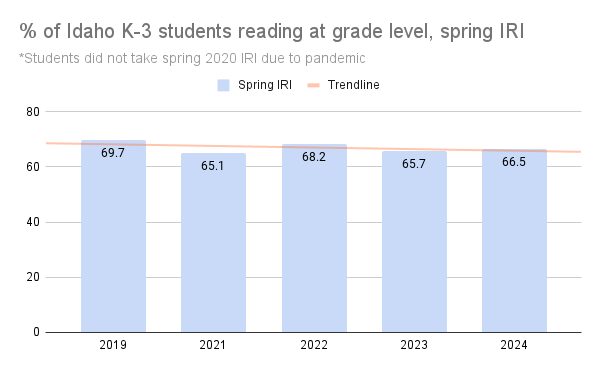About two-thirds of Idaho’s K-3 students are reading at grade level, according to results from a statewide reading exam held in the spring.
While about 60,000 young readers are on pace, nearly 30,000 are behind, and proficiency levels are still behind pre-pandemic scores.
Gains from the previous spring were minimal, and scores have perennially fallen short of state goals for reading achievement levels.
Since 2019, statewide spring reading scores have trended slightly downward.

When scores are broken down by grade level, they show slight improvements from 2023, except for second grade scores, which remained stagnant.
Since 2019, student literacy in grades 1-3 has gradually declined, while kindergarten literacy has gradually increased.
The results are from the Idaho Reading Indicator, a statewide exam that measures students’ reading ability each fall and spring. The test determines whether student literacy is at, near, or below grade level.
To learn more about the IRI and other statewide exams, go here.
For the first time since 2016, state education leaders are considering overhauling the exam. Some stakeholders have criticized the exam for being inaccurate, testing students’ ability with computers instead of reading, or reflecting social status rather than academic performance.
State education leaders emphasized the “moderate gains” in a press release Tuesday.
“We can expect to see steady improvements that our policy goals, like developing growth models that target our lowest performing readers, offering optional full-day kindergarten and emphasizing that our colleges prepare our educators to teach phonics were meant to bring,” Debbie Critchfield, the state superintendent, said. “As these policies are further implemented, district and statewide, we expect to see continued growth.”
This spring, about 17%, or nearly 15,000 students, were reading below grade level. The Idaho Department of Education aims to have fewer than 12% of K-3 students reading below grade level by spring 2027.
State leaders also aim to increase the rate of third graders reading at grade level to 80% by 2027, and decrease those reading below grade level to 8% or fewer.
“As we continue to provide training for educators in the science of reading and ways to work successfully with students showing signs of dyslexia and more, I expect that many of these longer-term goals will come into focus,” Ryan Cantrell, deputy superintendent, said.. “If we can maintain this trend of steady improvement, I believe that an increasing number of Idaho fourth graders will be fully prepared to perform to the best of their abilities through the rest of their academic careers.”
See the data
- Click here to see your district’s or charter’s score.
- Click here to see where your district or charter ranks.
- Click here to see your elementary school’s score.
- Click here to see where your elementary school ranks.
EdNews data analyst Randy Schrader contributed to this report. Check back in with EdNews in coming days for more coverage of the IRI.
